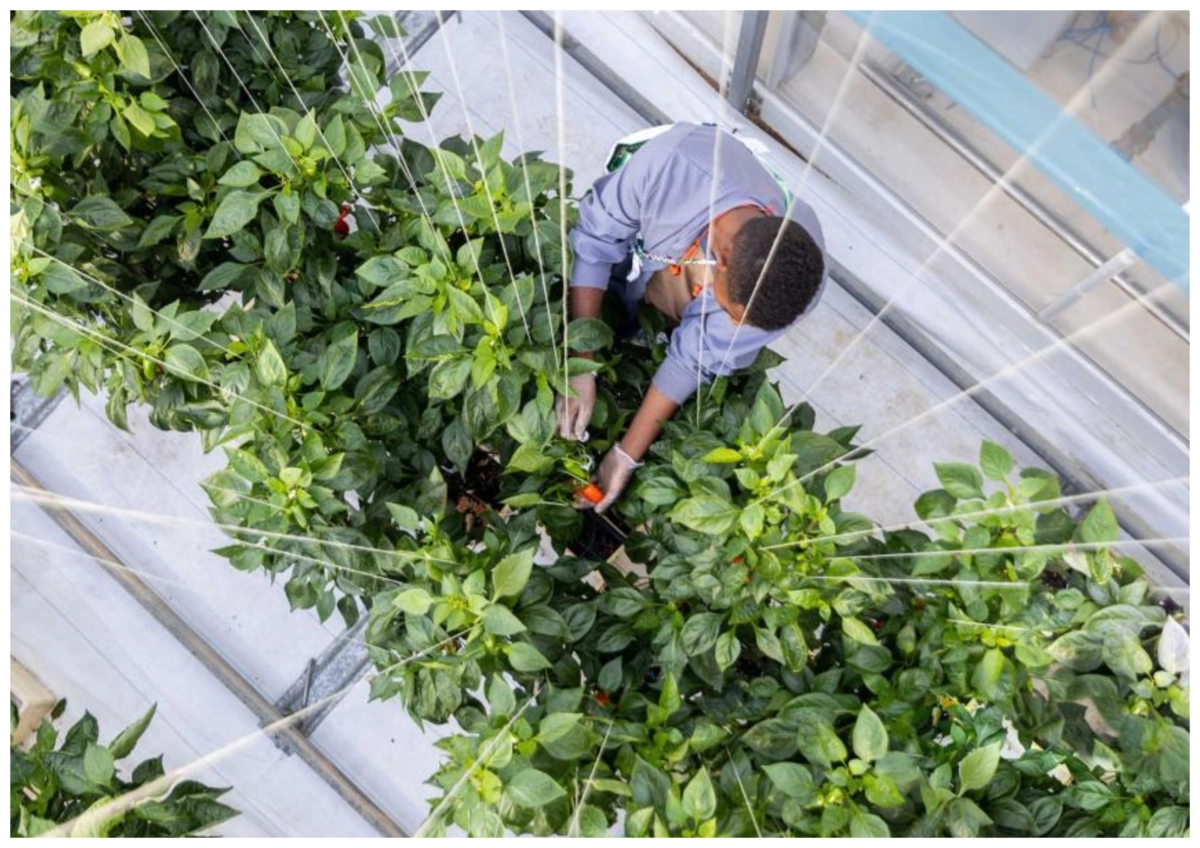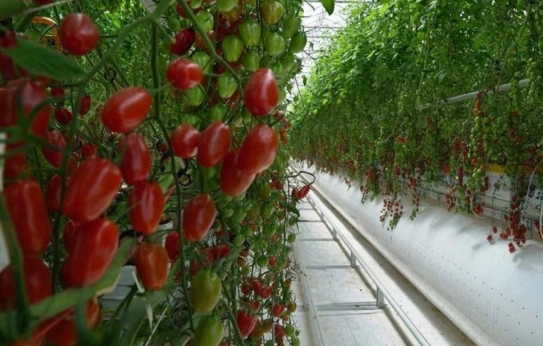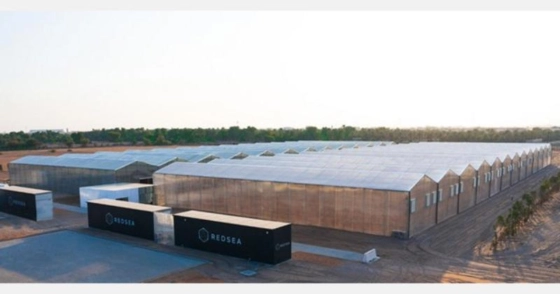Could Salt Water Be the Solution to Future Irrigation Woes?
Freshwater supplies are under stress as the global demand for food increases. Through selective breeding, one company is creating crops that can be irrigated with salt water.
Could Salt Water Be the Solution to Future Irrigation Woes?
Freshwater supplies are under stress as the global demand for food increases. Through selective breeding, one company is creating crops that can be irrigated with salt water.

Tomatoes grown with salt water at Red Sea Farms.courtesy of Red Sea Farms.
The vast majority—97 percent—of the earth’s water is salt water found in our oceans. Another two percent is stored in ice caps or glaciers. That leaves just one percent of all water on earth for regular human use: eating, drinking and growing food. And we’re dealing with an ever-dwindling supply. A 2013 study showed that about 40 percent of the world’s population lives in regions where demand for water exceeds supply.
When it comes to the freshwater supply that we do have, we use about 70 percent of it for irrigation. Estimates out of the UN’s Food and Agriculture Organization show that, by 2050, we’ll have to increase our global food supply by 60 percent. But we only have the freshwater resources to increase food supply by 10 percent. We literally do not have enough water to grow the food we will need in the coming decades.
Unfortunately, you can’t water plants with salt water because it’s too dense. The salt weighs the water down, and the plant isn’t able to absorb it through the soil. Instead, the higher salt levels will actually leech water out of the plant, and it will eventually shrivel and die.
But what if we could change that?
There have been attempts and studies before. A British company created an irrigation system that relied on salt water, and a Dutch farmer experimented with degrees of salinity on his row crops in 2014. Earlier this year, the USDA awarded a $10-million grant to researchers at the University of Florida and Clemson University who are looking at introducing salt water into irrigation. But one company is coming at the issue from a different angle: the crops themselves.

The aptly named Red Sea Farms, based in Saudi Arabia, is working to create plants that can be irrigated with salt water. Through selective breeding, the team at Red Sea is upping the salinity tolerance of crops, creating hardier crops able to thrive in salty conditions. “We’ve done testing from a high-tech, very controlled greenhouse to an open field in Egypt,” says Ryan Lefers, CEO and co-founder. “When the conditions are really difficult—it’s hot, it’s salty, it’s dry—that’s when you see the real benefit of our rootstocks. In some of our early-stage testing in Egypt, we’ve seen up to double the yields in those really difficult conditions.”
Founded in 2018 through the King Abdullah University of Science and Technology, the company studied common crops and the difficulties with growing them in desert regions without huge amounts of energy and water resources. Together with his co-founder, Mark Tester, Lefer began looking at tomatoes and their wild cousins. There are some breeds of wild tomatoes that grow fully in seawater, but they don’t produce palatable fruit. Tester and Lefer worked to get the salinity tolerance of those wild tomatoes into our everyday tomato plant.
“[Tester] had an ‘aha’ moment about three years ago, where he realized that a lot of greenhouse tomatoes are actually grafted,” says Lefer. “So, he could focus on developing a rootstock that had very good salinity tolerance, as well as heat tolerance, and then it just progressed from there.”
The tomatoes grown by Red Sea are typically sweeter than other grape or cherry tomatoes, as the plant produces more sugar to counteract the higher salt levels. Red Sea already sells some varieties of its tomatoes across Saudi Arabia, and it is working on growing peppers, cucumbers, squash and melons. Lefer says they’re not quite as far along with some of those plants, because they have a different plant and root system. But with plants that are grafted, such as pumpkins and watermelons, the process is largely the same.

Beyond selling the actual fruits, though, Red Sea is working to get its seedlings into the market, so growers can bring salt-water-tolerant plants to their local areas. “We’re starting to onboard nursery partners that can license the technology, so they would sell the seedlings into the market.” Right now, Lefer and his team utilize their own greenhouses and nurseries to grow seedlings and will also look to sell them to consumers.
The surprise benefit of growing salt-tolerant plants within a greenhouse system is that it could actually help with overall water usage and consumption. In a hydroponic system, water is recirculated. But ,as that water recirculates, the sodium chloride in the water builds up. Growing plants with higher salinity tolerance allows you to use that water longer, because the plants have a resistance to those buildups. “[That can], therefore, reduce fertilizer inputs and also reduce discharge of water that’s both salty and has a lot of fertilizer, which tends to go into a lagoon.”
Of course, there are concerns about using salt water in open fields. If you exclusively irrigate with salt water in one area, the salt will build up and the field could become hostile to other plants in the future. Lefer says keeping this in mind and keeping a firm hand on the crop rotation and management is the best way to prevent this. “It all comes down to management,” he says. “When irrigating with salt water, one must carefully consider soil type and also manage irrigation and crop selection in a proper way to leach salts out of the root zone.”

As our available supply of freshwater lessens, desert farmers will have to make some difficult decisions. They can grow fewer crops or move away from food crops into desert-friendly plantings. Or maybe they will have to stop farming altogether. Irrigating with salt water could allow farmers in arid regions to grow more crops or to expand the array of plants available to them. Lefer says he and Tester started their research with the goal of making farming easier in the worst conditions, but he’s found that this research has applications all over the world.
“We were looking ahead to the future by focusing on a present reality for a marginal section of agriculture,” says Lefer. “What’s happened is that, because we were focusing on those marginal conditions with high heat and high salt, it’s benefited back into mainstream agriculture, because mainstream agriculture is now facing these conditions more and more.”
Follow us
This work is licensed under a Creative Commons Attribution-NoDerivatives 4.0 International License.
Want to republish a Modern Farmer story?
We are happy for Modern Farmer stories to be shared, and encourage you to republish our articles for your audience. When doing so, we ask that you follow these guidelines:
Please credit us and our writers
For the author byline, please use “Author Name, Modern Farmer.” At the top of our stories, if on the web, please include this text and link: “This story was originally published by Modern Farmer.”
Please make sure to include a link back to either our home page or the article URL.
At the bottom of the story, please include the following text:
“Modern Farmer is a nonprofit initiative dedicated to raising awareness and catalyzing action at the intersection of food, agriculture, and society. Read more at <link>Modern Farmer</link>.”
Use our widget
We’d like to be able to track our stories, so we ask that if you republish our content, you do so using our widget (located on the left hand side of the article). The HTML code has a built-in tracker that tells us the data and domain where the story was published, as well as view counts.
Check the image requirements
It’s your responsibility to confirm you're licensed to republish images in our articles. Some images, such as those from commercial providers, don't allow their images to be republished without permission or payment. Copyright terms are generally listed in the image caption and attribution. You are welcome to omit our images or substitute with your own. Charts and interactive graphics follow the same rules.
Don’t change too much. Or, ask us first.
Articles must be republished in their entirety. It’s okay to change references to time (“today” to “yesterday”) or location (“Iowa City, IA” to “here”). But please keep everything else the same.
If you feel strongly that a more material edit needs to be made, get in touch with us at [email protected]. We’re happy to discuss it with the original author, but we must have prior approval for changes before publication.
Special cases
Extracts. You may run the first few lines or paragraphs of the article and then say: “Read the full article at Modern Farmer” with a link back to the original article.
Quotes. You may quote authors provided you include a link back to the article URL.
Translations. These require writer approval. To inquire about translation of a Modern Farmer article, contact us at [email protected]
Signed consent / copyright release forms. These are not required, provided you are following these guidelines.
Print. Articles can be republished in print under these same rules, with the exception that you do not need to include the links.
Tag us
When sharing the story on social media, please tag us using the following: - Twitter (@ModFarm) - Facebook (@ModernFarmerMedia) - Instagram (@modfarm)
Use our content respectfully
Modern Farmer is a nonprofit and as such we share our content for free and in good faith in order to reach new audiences. Respectfully,
No selling ads against our stories. It’s okay to put our stories on pages with ads.
Don’t republish our material wholesale, or automatically; you need to select stories to be republished individually.
You have no rights to sell, license, syndicate, or otherwise represent yourself as the authorized owner of our material to any third parties. This means that you cannot actively publish or submit our work for syndication to third party platforms or apps like Apple News or Google News. We understand that publishers cannot fully control when certain third parties automatically summarize or crawl content from publishers’ own sites.
Keep in touch
We want to hear from you if you love Modern Farmer content, have a collaboration idea, or anything else to share. As a nonprofit outlet, we work in service of our community and are always open to comments, feedback, and ideas. Contact us at [email protected].by Emily Baron Cadloff, Modern Farmer
October 23, 2023
Modern Farmer Weekly
Solutions Hub
Innovations, ideas and inspiration. Actionable solutions for a resilient food system.
ExploreExplore other topics
Share With Us
We want to hear from Modern Farmer readers who have thoughtful commentary, actionable solutions, or helpful ideas to share.
SubmitNecessary cookies are absolutely essential for the website to function properly. This category only includes cookies that ensures basic functionalities and security features of the website. These cookies do not store any personal information.
Any cookies that may not be particularly necessary for the website to function and are used specifically to collect user personal data via analytics, ads, other embedded contents are termed as non-necessary cookies.
Great story. Do the tomatoes taste saltier than those grown with fresh water?
Doesn’t salt water kill the the soil itself?
Sounds great, needs to go worldwide.
To answer David’s question: the article indicates that the tendency is to create sweeter fruit as the plants compensate for the salinity of the water.
“The tomatoes grown by Red Sea are typically sweeter than other grape or cherry tomatoes, as the plant produces more sugar to counteract the higher salt levels.”
Breeding crop varieties for salt water resistance should be considered as immediate requirement and Governments provide proper funds.